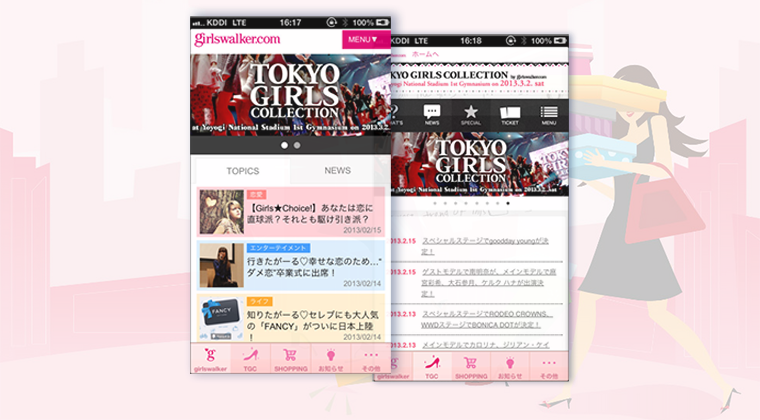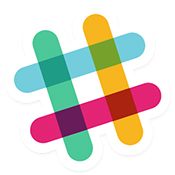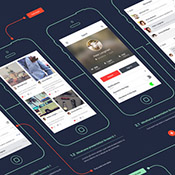
With 30+ requests for mobile development we get monthly, there are tonnes of questions our customers are curious about. Starting from their mobile app idea to choosing a technology.
That’s why we decided to bring a talk with Tomi Ahonen to you, who is among the TOP 30 Most Influential People in Mobile Advertising. Here he shares his advice over mobile industry, industries worth investing into mobile development, sales via mobile apps and even argues on the approach companies should take to deliver a mobile app their users will fail to resist from buying!
It’s doesn’t matter whether you’re developing a mobile strategy for your brand or are willing to improve the existing one, there are always things you can do better.
Development, marketing, choosing an industry, and special advice on mobile strategy itself. There was hardly any question related to mobile app development we haven’t asked.
WARNING: We’ve decided to keep all the Tomi’s thoughts as he shared them, though there are some of his ideas you might not really like :). So here we go!
Hi Tomi! Thanks so much for allowing time to share your experience with our readers. Perhaps someone is considering to take his business mobile now, which option is better to choose? Mobile app or a mobile website? If both, which is better to start from?
Hi Tanya, thanks for inviting! Actually neither. The first step for any business is always to enter mobile through SMS text messaging. That is what ‘mobile first’ means, it means to go messaging first, to reach every pocket, every human being who has a mobile phone. After the contact is made, then the offering can be expanded.
The second obvious step is to send messages with pictures, videos or sounds. The consumer thinks they are just pretty SMS text messages but for us, in the industry, it’s a different technology, called MMS.
22% of all SMS traffic worldwide is ‘premium SMS’
In other words it is interaction between a business and a person, like getting a banking password via SMS, or a notification of a parcel delivery, or voting on TV, or paying for a bus ticket by SMS. But with MMS, more than half of total MMS business is already premium MMS. Things like receiving our airplane boarding pass to our mobile phone via messaging. Via MMS. It looks like receiving an SMS text message with a pretty picture of our seat and the airline branding and the QR code. Or very like to things like TV shows and movies releasing trailers etc.

Ok, what should be the next step, since mobile messaging is just an option to get started?
After the consumer is engaged with us via messaging, we then should expand to the mobile internet. Make sure your internet pages are mobile optimized before you start this, because many consumers who use a smartphone to access a website, if they see it’s cumbersome to use on the phone, will never come back, but many will go to a competitor’s site next.
You don’t want to activate your customers to love mobile, hate your website, and go to a competitor.
Then, when you have a messaging strategy and a mobile website, you go for the more engaged consumers and offer them more via apps. The beauty of apps, is that you can give more powerful experiences that go deeper into the phone’s functionality in many cases, than just a mobile website service. So now you can for example use the phone book or the camera, things like that.
Could you give an example of a good mobile strategy of some app?
Coca Cola recently offered their guide for how to balance the mobile budget.
Put 70% in messaging, 20% onto the mobile web, and 10% for the apps.
I think this is a good guide. It is also how most early and successful pioneers have done, such as Finnair which invented the mobile check-in. They started with SMS, they evolved to MMS, then they added the mobile web, now they have apps and QR codes etc. They report more than half of Finnair passengers using mobile check-in and 23% of all frequent fliers who had received a paid upgrade offer to their phone on the day of travel, had actually clicked to buy and upgrade themselves for that flight. This is superbly powerful customer service and personalized marketing, but it all starts with the humble SMS. Those upgrade offers are all sent via messaging, they do not appear on the mobile website or the app. They are pushed via opt-in messaging. And the customers absolutely love the special treatment they are offered, to receive a personalized (and discounted) upgrade offer. As I said, 23% of Finnair frequent fliers who had received the paid upgrade offer had already taken it. This is a massive boost to Finnair’s profitability.
Great! Let’s expand to another issue. Which industry do you think is the best for selling via mobile today? Why?
Any industry can use mobile, and it’s not just for selling.
But to sell, the truly optimal industries are those that can have their service or product also delivered and consumed via mobile.
So things like news and entertainment, the camera function … that kind of things. Music, movies, TV, video games … But also nearly as useful are all the industries that rely on paper ticketing like buses, trains, airlines, movies, concerts, sporting events etc. Printing disposable paper tickets is an obsolete idea when every economically viable consumer has the ‘ticket displaying’ technology in their pockets. In Sweden for example 80% of all bus tickets are sold to mobile phone by mobile payments and displayed on the mobile screen.

Does mobile marketing worth it? Does it pay off?
Absolutely yes. The first use of mobile advertising is now 15 years old. I chaired the first mobile marketing and advertising conference 14 years ago in London. We’ve seen mobile advertising, which is a subset of mobile marketing, grow dramatically year after year, which was measured by eMarketer to be worth 46 billion dollars last year. That has been achieved in 14 years from zero dollars. The mobile advertising industry globally is far larger than say cinema box office revenues or the global music industry revenues. But those industries are growing typically at a few percent per year (or declining, as in the case of music). But mobile advertising? eMarketer said earlier this year, that mobile advertising was on form to grow 60% this year. Not 6%, 60%! It is a huge growth industry and one of the fastest-growing industries on the planet. Mobile already accounts for 8% of all advertising revenues, it is soon going to become larger than internet advertising which it has already done in many advanced mobile markets.

In your book “Communities Dominate Brands” you mention generation-C (which stands for the Community Generation). What are the tastes of Generation C in terms of mobile apps? Which app are they more likely to purchase and how to market such apps?
Generation C is the Connected generation, the Community generation. The generation that grew up on Facebook and social media. Their apps are strongly centered around social media so of course Facebook and Twitter are among the more popular mass market services (that Generation C has often been early users of, but are also tiring of) and more recent social media services like Pinterest, Snapchat etc. Note also, that they love and use YouTube and various video sharing services. Then the big passion for many Generation C consumers is in gaming and virtual worlds, so whatever is the latest game that everybody is doing. I wouldn’t even know. They also are early adopters in tech, so they would expect their bank to offer mobile banking and will often select the bank based on availability and scope of their mobile banking services (via app or web). They love the camera function, so any apps that enhance the camera, video recording, editing, sharing and viewing options are also popular.
Thanks for hints. Once you told that mobile apps are dead (or going to be) except for mobile games. But what do you think about “invisible” apps like Uber, Cloe or Digit? They’re able to do things a mobile website will never do. Is there a future for them?
Yes. An app can be an invaluable part of customer service. Take Uber. You can definitely provide a taxi booking service without an app, you can do it via mobile web, you can do it via SMS even (or even through voice IVR if we are precise). But an app gives more power to expand the experience. So do things like the mobile wallet, a loyalty program, sharing across other partners like Uber has done with Starbucks for example. And with things like identity since our mobile phone is becoming our identity card. The United Arab Emirates became the first country to offer a national driver’s licence via mobile phone. So we can enhance the experience, make it more seamless, and truly personalized via an app. There is nothing wrong with apps per se, only that for most consumer services and experiences, there is no utility to building an app, above what can be done via the mobile web.
Is it better to have a free mobile app and earn from downloads? Or should it be $0.99 with less downloads?
It depends on the target audience and the exact business model. I am a great believer in ‘freemium’ where about 90% of your users will take the totally free version that gives the full functionality of the main services, without any time limitations etc. Then some consumers appreciate premium and ‘power’ features, and about 9% are willing to pay a little bit for that, say 99 cents or 4.99 or whatever happens to be the pricing level relevant to that business. Then there is the 1% or 2% of super users who want the ultimate experience, and they’ll happily pay 9.99 or maybe even 29.99 for that ‘platinum’ level type of experience.

What is a good example of an app having such strategy?
We see this in Japan for example with the most popular teen youth magazine on mobile, Tokyo Girl also often known by its other Western translation as Girlswalker. Their mobile fashion, makeup and dating advice teen magazine comes out on mobile twice per week as a mobile web magazine. It is free. Then there is the premium version that you have to subscribe to, that has more content and instead of pictures, includes videos etc. It costs about 2.99 dollars per month. And then there is the platinum version as an app that includes things like free attendance to the live fashion shows, where the teens can buy clothes directly off the models, as they walk on the catwalk, just by pointing their camera phones at the models, to get the clothes in their own sizes etc, all bought and paid for on one click.
If we are talking about platforms: which platform is better to start developing a mobile app from: iOS or Android?
In almost all cases, to launch a mobile app to the mass market, you start with Android. Android has a far larger reach. The exceptions are two. One, if you are intending to sell to the marketing/advertising/media industries. They are in love with all Apple products, so then you should or could start with an iOS app. The other exception is prototyping. If you are planning the first app for any business or entity, it is almost always going to be done in the marketing or advertising (consumer service) area first. So let’s say, you want to advertise the catalog of your goods out of your retail stores, but on the mobile. Or you are a public transport service and want to sell tickets to mobile, etc. Consumer-focused, advertising or marketing, customer-service type of app. In that case, the ‘buyer’ of that app, internally at that company, will be the Vice President of Marketing. He or she will be using an iPhone. And as the iPhone is very good for rapid app development compared to some other platforms, that is how you probably want to do your prototype. Do it on the iPhone if your buyer is the VP of marketing at your client. But other than those two cases, all apps should be done Android first. And by the way, as Blackberry is shifting to Android, and Windows Phone is dying, you don’t need other platforms to even consider, than Android and iOS. Tizen might become meaningful in years to come but today not outside of India or the few countries where it has sold well.
What are the 3 mobile apps you can’t imagine your day without? 🙂
Haha there is honestly nothing. I have used a smartphone for sixteen years and early on, I would download every app that existed and compared and contrasted them. My work needs are around travel but almost all travel planning and arrangements I do with my laptop that I always have with me. So what I need on the phone is the mapping that is inbuilt. I used to have the early traveler apps that offered clocks in different time zones etc, but now modern smartphone clocks come with that functionality inbuilt so I don’t need the additional traveler apps that tell me what is the weather at my destination or whatever. I don’t find those useful anymore. If my travel was on one or two airlines, I would use their apps, but I fly annually on at least two dozen different airlines on all three alliances, so it would be hopeless to try to maintain up-to-date apps on all the airlines I fly. Same with hotels.
Wow I see. But if not travel and booking apps, do you relax playing some game from time to time or any social apps?
There are a lot of apps I’ve downloaded, played with a little bit and then stopped using. I have quit playing video games so I don’t do gaming on my phones. I am an avid Twitter user but I use the basic web version of Twitter (and on any new phone that gives me the mobile web version of Twitter, I immediately reset back to the traditional internet version of Twitter). I have probably downloaded every camera app and most video apps that ever was made but even with tons of them on my phone, I do my editing of pictures on my laptop and I use the base camera function on both of my smartphones. Although the Sony camera app was very clever that I used when I had my last Xperia two years ago. I would say I am very unusual as a smartphone consumer and have grown quite bored with the latest shiny things, I want to see what’s going on in my industry, mobile. I want to read the comments on my blog, and I want next to go to Twitter. I do that all on the mobile web (and far more, on a WiFi connection on my laptop at some airport lounge, hotel room, or Starbucks). But that is because I travel so much and always to different countries, for very short visits, so I won’t bother with the local SIM card and a 3G/4G cellular connection for what often is less than 48 hours, even often less than 24 hours in that one country. I’d love for truly reasonably priced global roaming data but that hasn’t been invented yet …
Well, though it sounds a bit critical and demanding, but we do believe this will only encourage readers to develop something that will stand out in the apps market. Thanks for your constructive advice and inspiration!
Thank you!
P.S. Dear readers, this was Tomi’s individual point of view. If you have some app in mind that you think worth discussion or you can’t live without – we’ll be happy to evaluate it in comments!






This was a real treat. Getting such valuable insight from a popular influencer like Tomi Ahonen. I agree with Android being a better option for launching a mobile app most of the time but sometimes you have to take a closer look at your target audience for that decision